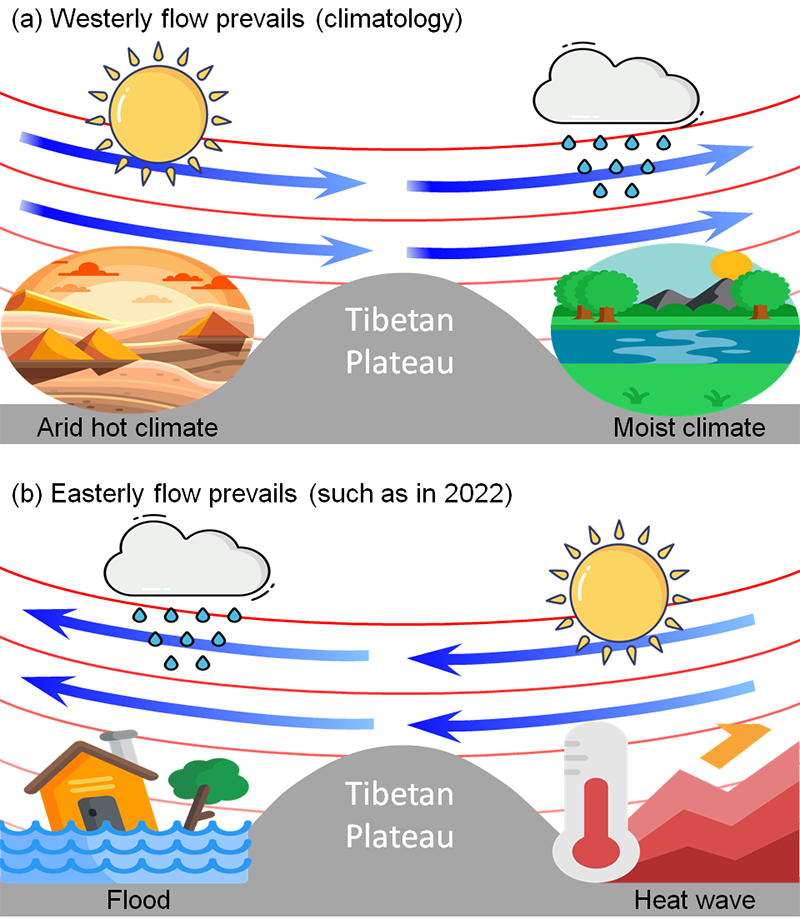In the mid-summer of 2022 (July-August), extreme climate events occurred over subtropical Asia. Persistent heat waves hit the Yangtze River valley (YRV) in East Asia, bringing secondary disasters such as drought, wildfires and power shortage. At the same time, frequent rainstorms and floods swept the desert areas from Western South Asia to West Asia, particularly over Pakistan in Western South Asia, causing great deaths and damages. The above two extreme climate events occurred simultaneously in subtropical Asia around 30°N, on the eastern and western sides of the Tibetan Plateau (TP), respectively. It is still unclear about the possible linkage between them and their possible causes. A recent study, published in
, has highlighted the reversal of zonal flow over the Tibetan Plateau.
"Heat waves in summer result directly from strong descending motion of the atmosphere, while rainstorms and floods are driven by strong ascent," said Dr. HE Chao, a research fellow from Jinan University, and the first author of the paper, "It is essential to understand why strong descent appeared on the eastern side of TP while strong ascent appeared on the western side of TP in 2022."
Atmospheric flow is constrained by some "rules" set by physical laws, and an important rule is that adiabatic air parcels must move along isentropic surfaces. Isentropic surfaces do not exactly follow a horizontal distribution, and they tilt slightly according to the thermal structure of atmosphere. Therefore, adiabatic flow may move upward/downward along the sloping isentropic surface and generate vertical motion. Following the atmospheric thermal structure over TP, the prevailing westerly flow near 30°N induces descent on the western side of TP and ascent on the eastern side of TP, accounting for the formation of the desert climate on the western side of TP and the humid climate on the eastern side of TP in summer (schematically illustrated in Figure 1a). However, the westerly flow over TP reversed into easterly flow in the summer of 2022, and it induced persistent descent and heat waves on the eastern side of TP, and ascent and excessive rainfall on the western side of TP (Figure 1b).

Fig. 1 Schematic diagram illustrating the mechanism how Asian summer climate is connected to the zonal flow over TP. (a) Climatological westerly flow prevails. (b) Easterly flow prevails such as in 2022. Red curves indicate isentropic surfaces, and arrows indicate the direction of air flow. As adiabatic flow moves along isentropic surfaces, westerly flow generates descent (ascent) on the western (eastern) side of TP, which account for the hot desert climate on the western side of TP and moist climate on the eastern side of TP. The vertical motion on the eastern and western sides of TP are swapped when easterly flow prevails over TP, accounting for the extreme heat wave (flood) on the eastern (western) side of TP in 2022. (Image by HE Chao)
"The mechanism can be simply understood as a 'swap' of the climate states between the eastern and western sides of TP, due to the reversed flow over TP in the summer of 2022," said Dr. HE Chao.
The reversed flow over TP in 2022 is suggested to be caused by the synergistic effects of atmospheric internal variability and oceanic forcing. An atmospheric wave train in the mid latitudes brought a clockwise rotational flow on the northern flank of TP, and it weakened the westerly flow over TP. This part of atmospheric circulation change is due to internal variability and thus highly unpredictable. Associated with a La Nina event, the tropical Indian Ocean is cooler than normal in the summer of 2022, and it further reduced the westerly flow over subtropical TP and increased the possibility of a reversed flow.
"Understanding the dynamics of extreme climate is a pre-requisite for predicting extreme climate," said Dr. ZHANG Lixia, a coauthor of the paper, a research scientist from the Institute of Atmospheric Physics, Chinese Academy of Sciences. "This study explains the concurrent occurrence of extreme climates across East Asia and Western South Asia in the summer of 2022. The results have implications for both climate attributions and climate projections."
Citation:
He C, Zhou T, Zhang L, Chen X, Zhang W (2023) Extremely hot East Asia and flooding western South Asia in the summer of 2022 tied to reversed flow over Tibetan Plateau. Climate Dynamics. https://doi.org/10.1007/s00382-023-06669-y
Media contact: Ms. LIN Zheng, jennylin@mail.iap.ac.cn

